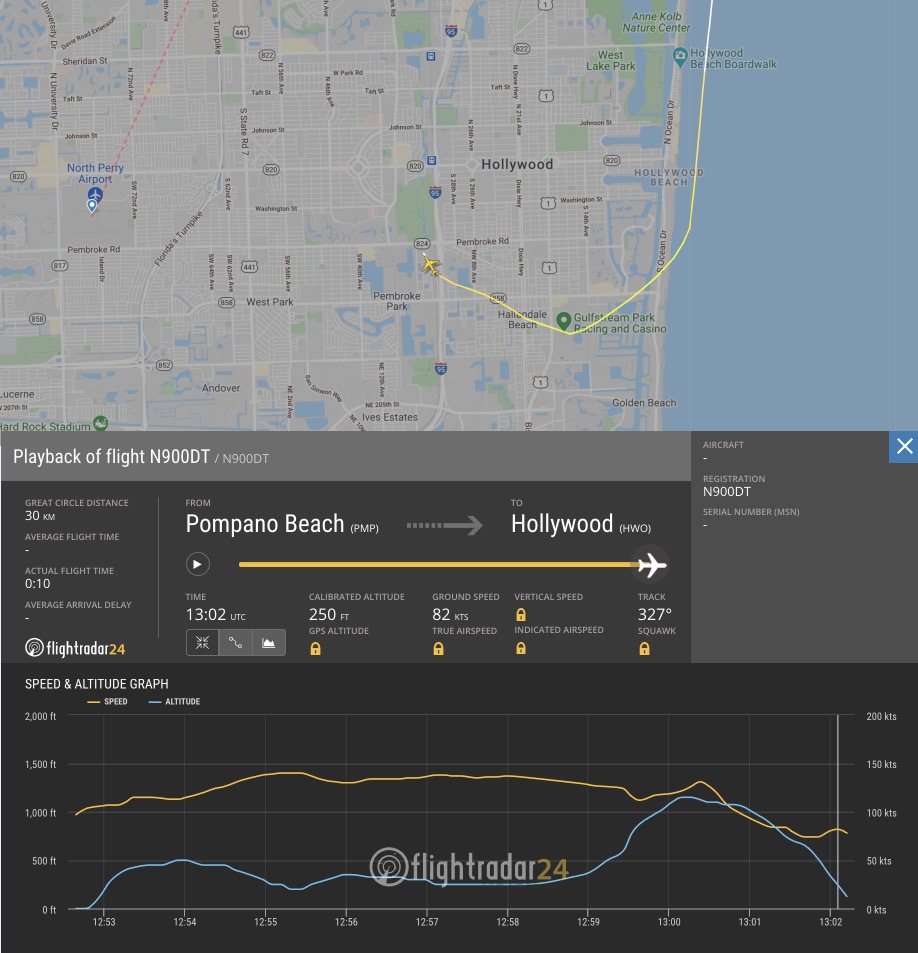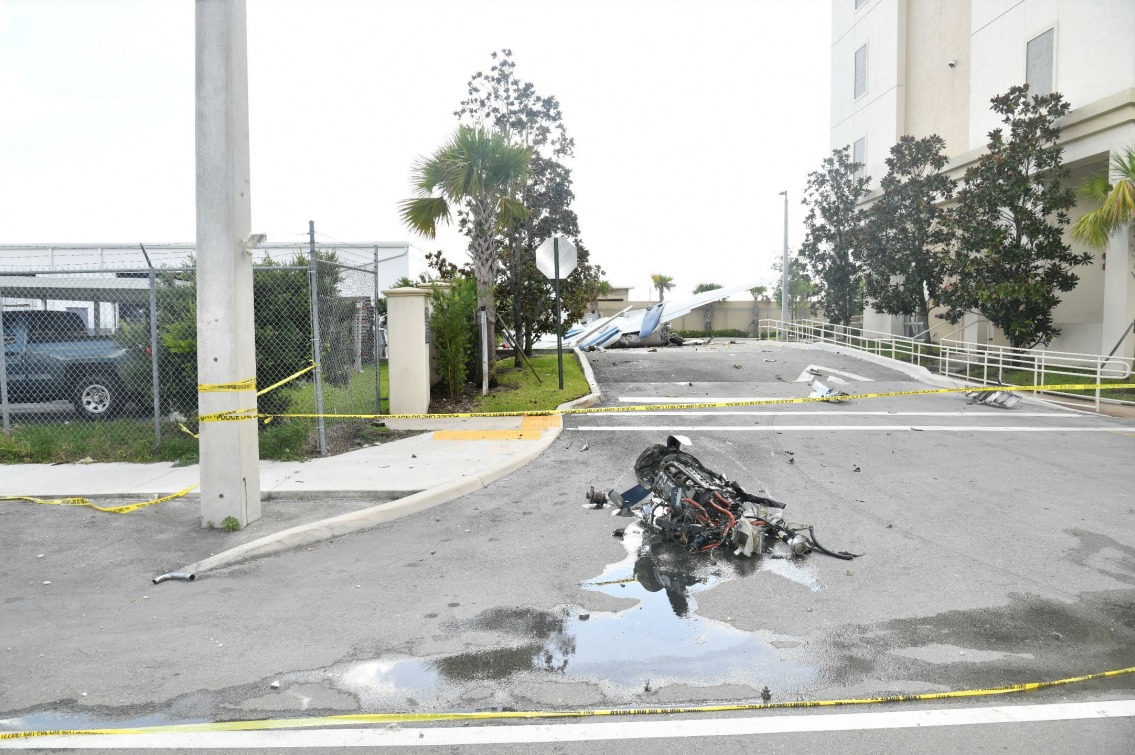
ASN Wikibase Occurrence # 240571
This information is added by users of ASN. Neither ASN nor the Flight Safety Foundation are responsible for the completeness or correctness of this information.
If you feel this information is incomplete or incorrect, you can submit corrected information.
| Date: | Friday 28 August 2020 |
| Time: | 09:02 |
| Type: |  Rockwell 500S Shrike Commander |
| Owner/operator: | Conquest Air |
| Registration: | N900DT |
| MSN: | 3056 |
| Year of manufacture: | 1969 |
| Total airframe hrs: | 10300 hours |
| Engine model: | Lycoming IO-540-E1B5 |
| Fatalities: | Fatalities: 2 / Occupants: 2 |
| Aircraft damage: | Destroyed |
| Category: | Accident |
| Location: | Pembroke Park, FL -
 United States of America United States of America
|
| Phase: | En route |
| Nature: | Training |
| Departure airport: | Pompano Beach Airport, FL (PPM/KPMP) |
| Miami-Opa locka Executive Airport, FL (OPF/KOPF) | |
| Investigating agency: | NTSB |
| Confidence Rating: |
On August 28, 2020, about 0902 eastern daylight time, an Aero Commander 500-S, N900DT, was destroyed when it impacted a building near Pembroke Park, Florida. The commercial pilot and airline transport pilot were fatally injured. The airplane was operated as a Title 14 Code of Federal Regulations (CFR) Part 91 familiarization flight.
The pilot-in-command seated in the right seat was providing familiarization in the multi-engine airplane to the left seat pilot during a flight to a nearby airport for fuel. Shortly after takeoff, one of the pilots reported an engine problem and advised that they were diverting to a nearby airport. A witness along the route of flight reported hearing the engines accelerating and decelerating and then popping sounds; several witnesses near the accident site reported hearing no engine sounds. The airplane impacted a building and terrain about 10 minutes after takeoff. Very minimal fuel leakage on the ground was noted and only 23 ounces of aviation fuel were collected from the airplane’s five fuel tanks. No evidence of preimpact failure or malfunction was noted for either engine or propeller; the damage to both propellers was consistent with low-to-no power at impact.
Since the pilot could not have visually verified the fuel level in the center fuel tank because of the low quantity of fuel prior to the flight, he would have had to rely on fuel consumption calculations since fueling based on flight time and the airplane’s fuel quantity indicating system. Although the fuel quantity indications at engine start and impact could not be determined postaccident from the available evidence, if the fuel quantity reading at the start of the flight was accurate based on the amount of fuel required for engine start, taxi, run-up, takeoff, and then only to fly the accident flight duration of 10 minutes, it would have been reading between 8 and 10 gallons. It is unlikely that the pilot, who was a chief pilot of a cargo operation and tasked with familiarizing company pilots in the airplane, would have knowingly initiated the flight with an insufficient fuel load for the intended flight or with the fuel gauge accurately registering the actual fuel load that was on-board.
Examination of the tank unit, or fuel quantity transmitter, revealed that the resistance between pins A and B, which were the ends of the resistor element inside the housing, fell within specification. When monitoring the potentiometer pin C, there was no resistance, indicating an open circuit between the wiper and the resistor element. X-ray imaging revealed that the conductor of electrical wire was fractured between the end of the lugs at the wiper and for pin C. Bypassing the fractured conductor, the resistive readings followed the position of the float arm consistent with normal operation. Visual examination of the wire insulation revealed no evidence of shorting, burning or damage. Examination of the fractured electrical conductor by the NTSB Materials Laboratory revealed that many of the individual wires exhibited intergranular fracture surface features with fatigue striations in various directions on some individual grains.
It is likely that the many fatigue fractured conductor strands of the electrical wire inside the accident tank unit or fuel transmitter resulted in the fuel gauge indicating that the tanks contained more fuel than the amount that was actually on board, which resulted in inadequate fuel for the intended flight and a subsequent total loss of engine power due to fuel exhaustion. The inaccurate fuel indication would also be consistent with the pilot’s decision to decline additional fuel before departing on the accident flight.
While the estimated fuel remaining since fueling (between 15 and 51 gallons) was substantially more than the actual amount on board at the start of the accident flight (between 8 and 10 gallons), the difference could have been caused by either not allowing the fuel to settle during fueling, and/or the operational use of the airplane. Ultimately, the fuel supply was likely completely exhausted during the flight, which resulted in the subsequent loss of power to both engines.
Given the circumstances of the accident, the effects from the right seat pilot’s use of cetirizine and the identified ethanol in the left seat pilot, which was likely from sources other than ingestion, did not contribute to this accident.
Probable Cause: A total loss of engine power due to fuel exhaustion. Contributing to the fuel exhaustion was the fatigue fracture of an electrical wire in the tank unit or fuel transmitter, which likely resulted in an inaccurate fuel quantity indication.
Accident investigation:
 |
|
Sources:
https://wsvn.com/news/local/2-killed-in-plane-crash-in-pembroke-park/?fbclid=IwAR2b0OnuYhWSZ-WYTK5dpPxIMvcR6OvXe0o1xHGOLwIcUQq3YPTECC_P51U
https://www.sun-sentinel.com/local/broward/pembroke-park/fl-ne-pembroke-park-plane-crash-20200828-bh73mbmrpfcdxhmxwtqb755vku-story.html?utm_source=feedburner&utm_medium=feed&utm_campaign=Feed%3A+SouthFloridaSun-sentinel-Outdoors+%28Outdoors+%2F+South+Florida+Sun-Sentinel%29
NTSB
https://www.flightradar24.com/data/aircraft/n900dt#2557f6de
https://www.liveatc.net/archive.php?m=kpmp
https://www.airhistory.net/photos/0121112
Location
Images:


Photo: NTSB
Revision history:
| Date/time | Contributor | Updates |
|---|---|---|
| 28-Aug-2020 14:32 | Captain Adam | Added |
| 28-Aug-2020 15:29 | RobertMB | Updated [Time, Aircraft type, Registration, Cn, Operator, Phase, Nature, Departure airport, Destination airport, Source, Narrative] |
| 28-Aug-2020 15:39 | Captain Adam | Updated [Narrative] |
| 28-Aug-2020 17:21 | RobertMB | Updated [Narrative] |
| 28-Aug-2020 18:36 | Iceman 29 | Updated [Country, Embed code] |
| 28-Aug-2020 18:40 | Iceman 29 | Updated [Source, Photo] |
| 28-Aug-2020 18:42 | A.J.Scholten | Updated [Country] |
| 28-Aug-2020 18:50 | Anon. | Updated [Country] |
| 29-Aug-2020 08:54 | Anon. | Updated [Source, Narrative] |
| 29-Aug-2020 09:33 | Iceman 29 | Updated [Embed code] |
| 30-Aug-2020 06:15 | Anon. | Updated [Destination airport] |
| 31-Aug-2020 06:20 | aaronwk | Updated [Source, Narrative] |
| 19-Sep-2020 02:08 | Captain Adam | Updated [Narrative] |
| 23-Sep-2020 12:01 | ASN Update Bot | Updated [Time, Operator, Nature, Departure airport, Destination airport, Source, Embed code, Narrative, Accident report] |
| 22-Apr-2021 19:53 | SANMJN | Updated [Departure airport, Destination airport, Source, Embed code] |
| 22-Apr-2021 19:53 | harro | Updated [Departure airport] |
| 22-Sep-2022 08:29 | Captain Adam | Updated [Location, Nature, Source, Embed code, Narrative, Accident report, Photo] |
Corrections or additions? ... Edit this accident description
The Aviation Safety Network is an exclusive service provided by:


 ©2024 Flight Safety Foundation
©2024 Flight Safety Foundation